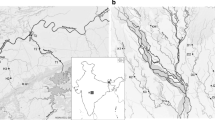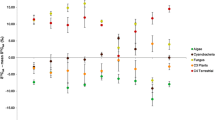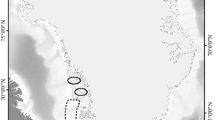Abstract
Terrestrial and marine ecosystems in Southeast Alaska are linked by the flow of freshwater from precipitation and glacial runoff, which transports nutrients and organic matter (OM) downstream to estuaries. We examined the contribution of terrestrial-riverine and marine OM to diets of fishes (N = 257, four species) and invertebrates (N = 90, six species) collected from glacially influenced estuaries in Southeast Alaska using multiple stable isotopes (δ13C, δ15N, and δ34S). Multivariate analysis of similarity (ANOSIM) was used to quantify variation in stable isotope composition of consumers across 6 months and three sites with watersheds that differed in their glacier and forest composition. Fishes showed weak differences (ANOSIM R = 0.141) in stable isotope composition among sampling months, moderate differences (ANOSIM R = 0.375) among sites, and strong differences (ANOSIM R = 0.583) among species. Invertebrates showed moderate differences (ANOSIM R = 0.352) in stable isotope composition among sampling months and strong differences among sites (ANOSIM R = 0.710) and species (ANOSIM R = 0.858). We found the greatest differences in stable isotope composition between the two estuary sites with watersheds containing the highest and lowest glacial coverage, indicating that the contribution of allochthonous OM to consumer diets varies across watershed types. Invertebrates collected from the site with the lowest glacial coverage in the watershed were more depleted in δ13C and δ34S, indicating higher use of terrestrial-riverine OM, than those at sites with higher watershed glacial coverage. High variation in stable isotope composition among species, months, and sites underscores the complexity of estuary food web responses to future glacier loss.



Similar content being viewed by others
References
Abrantes, K.G., A. Barnett, T.R. Marwick, and S. Bouillon. 2013. Importance of terrestrial subsidies for estuarine food webs in contrasting East African catchments. Ecosphere 4: 1–33. doi:10.1890/ES12-00322.1.
Arimitsu, M. 2016. The influence of glaciers on coastal marine ecosystems in the Gulf of Alaska. Alaska: Dissertation, University of Alaska Fairbanks.
Bell, L.E., B.A. Bluhm, and K. Iken. 2016. Influence of terrestrial organic matter in marine food webs of the Beaufort Sea shelf and slope. Marine Ecology Progress Series 550: 1–24. doi:10.3354/meps11725.
Boon, P.I., P.C. Pollard, and D. Ryder. 2006. Wetland microbial ecology and biogeochemistry. In Ecology of Freshwater and Estuarine Wetlands, ed. D.P. Batzer and R.R. Sharitz. Berkeley: University of California Press.
Bouillon, S., P. Chandra Mohan, N. Sreenivas, and F. Dehairs. 2000. Sources of suspended organic matter and selective feeding by zooplankton in an estuarine mangrove ecosystem as traced by stable isotopes. Marine Ecology Progress Series 208: 79–92. doi:10.3354/meps208079.
Brittain, J.E., and A.M. Milner. 2001. Ecology of glacier-fed rivers: Current status and concepts. Freshwater Biology 46: 1571–1578. doi:10.1046/j.1365-2427.2001.00845.x.
Buchheister, A., and R.J. Latour. 2010. Turnover and fractionation of carbon and nitrogen stable isotopes in tissues of a migratory coastal predator, summer flounder (Paralichthys dentatus). Canadian Journal of Fisheries and Aquatic Sciences 67: 445–461. doi:10.1139/F09-196.
Chipps, S.R., and J.E. Garvey. 2007. Assessment of diets and feeding patterns. In Analysis and interpretation of freshwater fisheries data, ed. C. Guy, 473–514. Bethesda: American Fisheries Society.
City and Borough of Juneau (CBJ). 2016. Juneau trails project from the City and Borough of Juneau: Cowee-Davies. http://www.juneau.org/parkrec/trails/coweedavies.php.
Clarke, K.R., and R.N. Gorley. 2015. PRIMER v7: User manual/tutorial. Plymouth: PRIMER-E.
Clarke, K.R., R.N. Gorley, P.J. Somerfield, and R.M. Warwick. 2014. Change in marine communities: An approach to statistical analysis and interpretation. Plymouth: PRIMER-E.
Connolly, R.M., M.A. Guest, A.J. Melville, and J.M. Oakes. 2004. Sulfur stable isotopes separate producers in marine food-web analysis. Oecologia 138: 161–167. doi:10.1007/s00442-003-1415-0..
Creque, S.M., and S.J. Czesny. 2012. Diet overlap of non-native Alewife with native yellow perch and spottail shiner in nearshore waters of southwestern Lake Michigan, 2000-2007. Ecology of Freshwater Fish 21: 207–221. doi:10.1111/j.1600-0633.2011.00538.x.
Darnaude, A.M., C. Salen-Picard, N.V.C. Polunin, and M.L. Harmelin-Vivien. 2004. Trophodynamic linkage between river runoff and coastal fishery yield elucidated by stable isotope data in the Gulf of Lions (NW Mediterranean). Oecologia 138: 325–332. doi:10.1007/s00442-003-1457-3.
Deegan, L.A., and R.H. Garritt. 1997. Evidence for spatial variability in estuarine food webs. Marine Ecology Progress Series 147: 31–47. doi:10.3354/meps147031.
DeNiro, M.J., and S. Epstein. 1978. Influence of diet on the distribution of carbon isotopes in animals. Geochimica et Cosmochimica Acta 42: 495–506. doi:10.1016/0016-7037(78)90199-0.
Douglas Island Pink & Chum Inc. (DIPAC). 2015. Annual Management Plan, Macaulay and Sheep Creek Hatcheries. https://www.adfg.alaska.gov/static/fishing/PDFs/hatcheries/annual_management_plans/2015/2015_msh_amp.pdf.
Duffy, E.J., D.A. Beauchamp, R.M. Sweeting, R.J. Beamish, and J.S. Brennan. 2010. Ontogenetic diet shifts of juvenile Chinook salmon in nearshore and offshore habitats of Puget Sound. Transactions of the American Fisheries Society 139: 803–823. doi:10.1577/t08-244.1.
Dunton, K.H., T. Weingartner, and E.C. Carmack. 2006. The nearshore western Beaufort Sea ecosystem: Circulation and importance of terrestrial carbon in arctic coastal food webs. Progress in Oceanography 71: 362–378. doi:10.1016/j.pocean.2006.09.011.
Dunton, K.H., S.V. Schonberg, and L.W. Cooper. 2012. Food web structure of the Alaskan nearshore shelf and estuarine lagoons of the Beaufort Sea. Estuaries and Coasts 35: 416–435. doi:10.1007/s12237-012-9475-1.
Eyre, B. 1998. Transport, retention and transformation of material in Australian estuaries. Estuaries 21: 540. doi:10.2307/1353293.
Fellman, J.B., R.G.M. Spencer, P.J. Hernes, R.T. Edwards, D.V. D’Amore, and E. Hood. 2010. The impact of glacier runoff on the biodegradability and biochemical composition of terrigenous dissolved organic matter in near-shore marine ecosystems. Marine Chemistry 121: 112–122. doi:10.1016/j.marchem.2010.03.009.
Fellman, J.B., S. Nagorski, S. Pyare, A.W. Vermilyea, D. Scott, and E. Hood. 2014. Stream temperature response to variable glacier coverage in coastal watersheds of Southeast Alaska. Hydrological Processes 28: 2062–2073. doi:10.1002/hyp.9742.
Fellman, J.B., E. Hood, P.A. Raymond, J. Hudson, M. Bozeman, and M. Arimitsu. 2015. Evidence for the assimilation of ancient glacier organic carbon in a proglacial stream food web. Limnology and Oceanography 60: 1118–1128. doi:10.1002/lno.10088.
Finlay, J.C. 2001. Stable-carbon-isotope ratios of river biota: implications for energy flow in lotic food webs. Ecology 82: 1052–1064. doi:10.1890/0012-9658(2001)082[1052:SCIROR]2.0.CO;2.
Finlay, J.C., and C. Kendall. 2007. Stable isotope tracing of temporal and spatial variability in organic matter sources to freshwater ecosystems. In Stable Isotopes in Ecology and Environmental Science, ed. R.H. Michener and K. Lajtha, 2nd ed., 283–333. Malden: Blackwell Publishing.
Franca, S., R.P. Vasconcelos, S. Tanner, C. Maguas, M.J. Costa, and H.N. Cabral. 2011. Assessing food web dynamics and relative importance of organic matter sources for fish species in two Portuguese estuaries: A stable isotope approach. Marine Environmental Research 72: 204–215. doi:10.1016/j.marenvres.2011.09.001.
Goering, J., V. Alexander, and N. Haubenstock. 1990. Seasonal variability of stable carbon and nitrogen isotope ratios of organisms in a North Pacific Bay. Estuarine, Coastal and Shelf Science 30: 239–260. doi:10.1016/0272-7714(90)90050-2.
Heady, W.N., and J.W. Moore. 2013. Tissue turnover and stable isotope clocks to quantify resource shifts in anadromous rainbow trout. Oecologia 172: 21–34. doi:10.1007/s00442-012-2483-9.
Hedges, J.I., R.G. Keil, and R. Brenner. 1997. What happens to terrestrial organic matter in the ocean? Organic Geochemistry 27: 195–212. doi:10.1016/S0146-6380(97)00066-1.
Hill, J.M., and C.D. McQuaid. 2011. Stable isotope methods: The effect of gut contents on isotopic ratios of zooplankton. Estuarine, Coastal and Shelf Science 92: 480–485. doi:10.1016/j.ecss.2011.02.002.
Hill, D.F., N. Bruhis, S.E. Calos, A. Arendt, and J. Beamer. 2015. Spatial and temporal variability of freshwater discharge into the Gulf of Alaska. Journal of Geophysical Research: Oceans 120: 634–646. doi:10.1002/2014JC010395.
Hoffman, J.C., D.A. Bronk, and J.E. Onley. 2007. Contribution of allochthonous carbon to American shad production in the Mattaponi River, Virginia, using stable isotopes. Estuaries and Coasts 30: 1034–1048. doi:10.1007/BF02841394.
Hood, E., and L. Berner. 2009. Effects of changing glacial coverage on the physical and biogeochemical properties of coastal streams in southeastern Alaska. Journal of Geophysical Research 114. doi:10.1029/2009jg000971.
Hood, E., J. Fellman, R.G.M. Spencer, P.J. Hernes, R. Edwards, D. D’Amore, and D. Scott. 2009. Glaciers as a source of ancient and labile organic matter to the marine environment. Nature 462: 1044–1047. doi:10.1038/nature08580.
Howe, E.R. 2012. Detrital shadows: evaluating landscape and species effects on detritus-based food web connectivity in Pacific Northwest estuaries. Washington: Dissertation, University of Washington.
Howe, E.R., and C.A. Simenstad. 2011. Isotopic determination of food web origins in restoring and ancient estuarine wetlands of the San Francisco Bay and Delta. Estuaries and Coasts 34: 597–617. doi:10.1007/s12237-011-9376-8.
Howe, E.R., and C.A. Simenstad. 2015. Using stable isotopes to discern mechanisms of connectivity in estuarine detritus-based food webs. Marine Ecology Progress Series 518: 13–29. doi:10.3354/meps11066.
Jaecks, T., and T.P. Quinn. 2014. Ontogenetic shift to dependence on salmon-derived nutrients in Dolly Varden char from the Iliamna River, Alaska. Environmental Biology of Fishes 97: 1323–1333. doi:10.1007/s10641-014-0221-3.
Larsen, C.F., R.J. Motyka, A.A. Arendt, K.A. Echelmeyer, and P.E. Geissler. 2007. Glacier changes in southeast Alaska and northwest British Columbia and contribution to sea level rise. Journal of Geophysical Research 112: F01007. doi:10.1029/2006JF000586.
Larsen, C.F., E. Burgess, A.A. Arendt, S. O’Neel, A.J. Johnson, and C. Kienholz. 2015. Surface melt dominates Alaska glacier mass balance. Geophysical Research Letters 42: 5902–5908. doi:10.1002/2015GL064349.
Lisi, P.J., D.E. Schindler, K.T. Bentley, and G.R. Pess. 2013. Association between geomorphic attributes of watersheds, water temperature, and salmon spawn timing in Alaskan streams. Geomorphology 185: 78–86. doi:10.1016/j.geomorph.2012.12.013.
Martineau, C., W.F. Vincent, J.J. Frenette, and J.J. Dodson. 2004. Primary consumers and particulate organic matter: Isotopic evidence of strong selectivity in the estuarine transition zone. Limnology and Oceanography 49: 1679–1686. doi:10.4319/lo.2004.49.5.1679.
Marty, J., and D. Planas. 2008. Comparison of methods to determine algal δ13C in freshwater. Limnology and Oceanography: Methods 6: 51–63. doi:10.4319/lom.2008.6.51.
McCutchan, J.H., W.M. Lewis, C. Kendall, and C.C. McGrath. 2003. Variation in trophic shift for stable isotope ratios of carbon, nitrogen, and sulfur. Oikos 2: 378–390. doi:10.1034/j.1600-0706.2003.12098.x.
Michener, R.H., and L. Kaufman. 2007. Stable isotope ratios as tracers in marine food webs: An update. In Stable Isotopes in Ecology and Environmental Science, ed. R.H. Michener and K. Lajtha, 2nd ed., 239–282. Malden: Blackwell Publishing.
Milner, A.M., and G.E. Petts. 1994. Glacial rivers: Physical habitat and ecology. Freshwater Biology 32: 295–307. doi:10.1111/j.1365-2427.1994.tb01127.x.
Montoya, J.P. 2007. Natural abundance of 15N in marine planktonic ecosystems. In Stable Isotopes in Ecology and Environmental Science, ed. R.H. Michener and K. Lajtha, 2nd ed., 176–201. Malden: Blackwell Publishing.
National Weather Service. 2015. Juneau Alaska annual climate summary for the year of 2014. Juneau: U.S. Department of Commerce, NOAA http://w2.weather.gov/climate/index.php?wfo=PAJK.
Neal, E.G., E. Hood, and K. Smikrud. 2010. Contribution of glacier runoff to freshwater discharge into the Gulf of Alaska. Geophysical Research Letters 37: L06404. doi:10.1029/2010gl042385.
O’Neel, S., E. Hood, A.L. Bidlack, S.W. Fleming, M.L. Arimitsu, A. Arendt, E. Burgess, et al. 2015. Icefield-to-ocean linkages across the northern Pacific coastal temperate rainforest ecosystem. Bioscience 65: 499–512. doi:10.1093/biosci/biv027.
Pasquaud, S., J. Lobry, and P. Elie. 2007. Facing the necessity of describing estuarine ecosystems: A review of food web ecology study techniques. Hydrobiologia 588: 159–172. doi:10.1007/s10750-007-0660-3.
Peterson, B.J., and B. Fry. 1987. Stable isotopes in ecosystem studies. Annual Review of Ecology and Systematics 18: 293–320. doi:10.1146/annurev.es.18.110187.001453.
Peterson, B.J., and R.W. Howarth. 1987. Sulfur, carbon, and nitrogen isotopes used to trace organic matter flow in the salt-marsh estuaries of Sapelo Island, Georgia. Limnology and Oceanography 32: 1195–1213. doi:10.4319/lo.1987.32.6.1195.
Peterson, B.J., R.W. Howarth, and R.H. Garritt. 1985. Multiple stable isotopes used to trace the flow of organic matter in estuarine food webs. Science 227: 1361–1363. doi:10.1126/science.227.4692.1361.
Peterson, B.J., B. Fry, M. Hullar, S. Saupe, and R. Wright. 1994. The distribution and stable carbon isotopic composition of dissolved organic carbon in estuaries. Estuaries 17: 111–121. doi:10.2307/1352560.
Polis, G.A., W.B. Anderson, and R.D. Holt. 1997. Toward an integration of landscape and food web ecology: The dynamics of spatially subsidized food webs. Annual Review of Ecology and Systematics 28: 289–316. doi:10.1146/annurev.ecolsys.28.1.289.
Post, D.M., C.A. Layman, D.A. Arrington, G. Takimoto, J. Quattrochi, and C.G. Montaña. 2007. Getting to the fat of the matter: Models, methods and assumptions for dealing with lipids in stable isotope analyses. Oecologia 152: 179–189. doi:10.1007/s00442-006-0630-x.
Raymond, P.A., and J.E. Bauer. 2001. Riverine export of aged terrestrial organic matter to the North Atlantic Ocean. Nature 409: 497–500. doi:10.1038/35054034.
Schlesinger, W.H., and J.M. Melack. 1981. Transport of organic carbon in the world’s rivers. Tellus 33: 172–187. doi:10.1111/j.2153-3490.1981.tb01742.x.
Spencer, R.G.M., J.M.E. Ahad, A. Baker, G.L. Cowie, R. Ganeshram, R.C. Upstill-Goddard, and G. Uher. 2007. The estuarine mixing behaviour of peatland derived dissolved organic carbon and its relationship to chromophoric dissolved organic matter in two North Sea estuaries (U.K.). Estuarine, Coastal and Shelf Science 74: 131–144. doi:10.1016/j.ecss.2007.03.032.
Syvitski, J.P.M., A.J. Kettner, A. Correggiari, and B.W. Nelson. 2005. Distributary channels and their impact on sediment dispersal. Marine Geology 222–223: 75–94. doi:10.1016/j.margeo.2005.06.030.
Szabo, A., A. Tudge, J. Macnamara, and H.G. Thode. 1950. Distribution of S34 in nature and the sulfur cycle. Science 111: 464–465. doi:10.1126/science.111.2887.464.
U.S. Department of Agriculture Forest Service (USDAFS) Tongass National Forest. 2014. AK Hydro Streams in Southeast Alaska. Alaska: Southeast Alaska GIS Library http://seakgis.alaska.edu/data/SEAKHydro_Snapshot.zip.
Vander Zanden, M.J., and J.B. Rasmussen. 2001. Variation in δ15N and δ13C trophic fractionation: Implications for aquatic food web studies. Limnology and Oceanography 46: 2061–2066. doi:10.4319/lo.2001.46.8.2061.
Vaslet, A., D.L. Phillips, C. France, I.C. Feller, and C.C. Baldwin. 2012. The relative importance of mangroves and seagrass beds as feeding areas for resident and transient fishes among different mangrove habitats in Florida and Belize: Evidence from dietary and stable-isotope analyses. Journal of Experimental Marine Biology and Ecology 434–435: 81–93. doi:10.1016/j.jembe.2012.07.024.
Vinagre, C., J. Salgado, M.J. Costa, and H.N. Cabral. 2008. Nursery fidelity, food web interactions and primary sources of nutrition of the juveniles of Solea solea and S. senegalensis in the Tagus estuary (Portugal): A stable isotope approach. Estuarine, Coastal and Shelf Science 76: 255–264. doi:10.1016/j.ecss.2007.07.006.
Weingartner, T., L. Eisner, G.L. Eckert, and S. Danielson. 2009. Southeast Alaska: Oceanographic habitats and linkages. Journal of Biogeography 36: 387–400. doi:10.1111/j.1365-2699.2008.01994.x.
Whitney, E.J. 2016. Trophic ecology of nearshore fishes in glacially-influenced estuaries of Southeast Alaska. Alaska: Thesis, University of Alaska Fairbanks.
Wipfli, M.S., and D.P. Gregovich. 2002. Export of invertebrates and detritus from fishless headwater streams in southeastern Alaska: Implications for downstream salmonid production. Freshwater Biology 47: 957–969. doi:10.1046/j.1365-2427.2002.00826.x.
Acknowledgements
We thank Asia Beder, Doug Duncan, Ragnhildur Fridriksdottir, Melissa Rhodes-Reese, and many field volunteers for their assistance in collecting fish and invertebrate samples. Thanks to Carolyn Bergstrom, Franz Mueter, and two anonymous reviewers for their insightful comments on earlier drafts of this manuscript. This study was funded by the Alaska Experimental Program to Stimulate Competitive Research (EPSCoR) NSF award no. OIA-1208927, Alaska Sea Grant (award no. RR/14-01), and the University of Alaska Fairbanks.
Author information
Authors and Affiliations
Corresponding author
Additional information
Communicated by Kenneth Dunton
Rights and permissions
About this article
Cite this article
Whitney, E.J., Beaudreau, A.H. & Howe, E.R. Using Stable Isotopes to Assess the Contribution of Terrestrial and Riverine Organic Matter to Diets of Nearshore Marine Consumers in a Glacially Influenced Estuary. Estuaries and Coasts 41, 193–205 (2018). https://doi.org/10.1007/s12237-017-0260-z
Received:
Revised:
Accepted:
Published:
Issue Date:
DOI: https://doi.org/10.1007/s12237-017-0260-z




